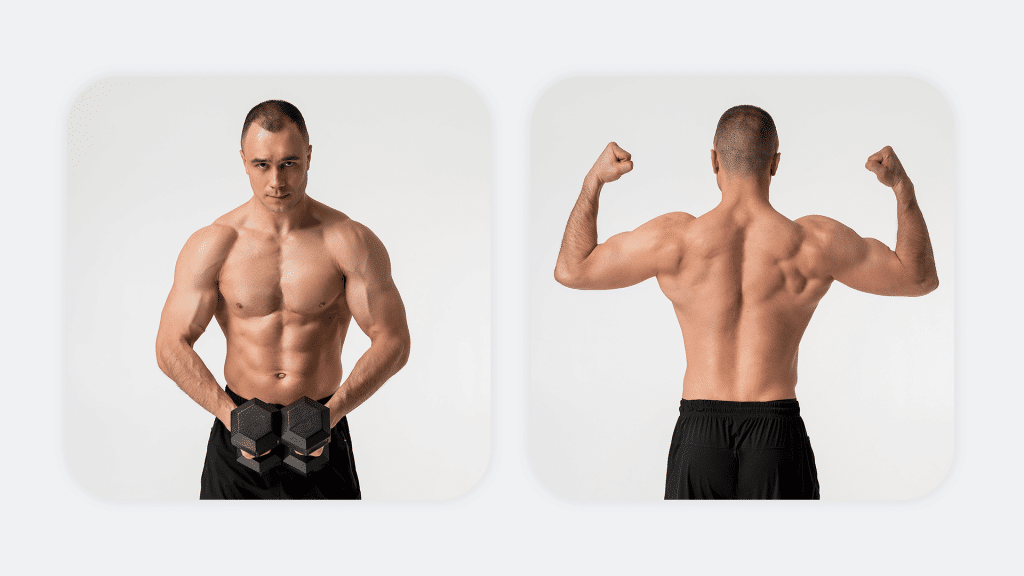Calisthenics and weight training have one thing in common—they’re both strength training activities. Meaning they build muscle, enhance strength, and offer a host of shared benefits. However, the benefits can vary significantly when you look at how soon you see results, which results you see, and the overall impact on your body composition.
To make the right decision, you’ll need to understand the difference between calisthenics and weight training and the unique advantages each brings to the table.
Calisthenics relies on bodyweight exercises that can promote flexibility, balance, and control through movements. Weight training, on the other hand, focuses on resistance exercises that stimulate muscle growth and strength.
Integrating both into your fitness regime could potentially provide a comprehensive workout. But, should you do them both? If yes, how should you go about it?
Here’s everything you need to know.
Looking for a way to break the vicious cycle of weight loss and tone up all the jiggly parts? Watch the extra pounds fly off and your muscles firm up with the BetterMe app!
Can I Do Calisthenics and Weight Training Combined?
Yes, you can do both strength-building regimes. In fact, calisthenics and weight training combined can yield impressive results.
The benefits of a combined routine are manifold. Calisthenics, with its focus on bodyweight exercises, promotes flexibility, balance, and control, essential elements of functional fitness.
Weight training regularly can enhance muscle growth and strength, helping you to lift heavier and thereby improving your muscular capabilities.
Together, these can deliver an overall workout that builds endurance, stamina, and strength in a balanced manner.
There are several ways to blend calisthenics and weight training into your fitness schedule:
- Warm-up: Incorporate simple calisthenics, like jumping jacks or burpees, in your warm-up routine before hitting the weights. This raises your heart rate and prepares your body for the intense workout ahead.
- Same Day: You can start with a calisthenics and weight training workout plan on the same day. For example, start with calisthenics exercises such as pull-ups or push-ups, then move on to weight lifting.
- Alternate Days: Follow a calisthenics routine one day and switch to a weight training program the next, focusing on different muscles. This gives your muscles time to rest and recover.
- Alternate Cycles: Dedicate a few weeks solely to calisthenics to build muscle, then switch to a period of weight training. This pattern can challenge your muscles and keep your workouts exciting.
Although combining these two training methods can be beneficial, there are a few risks worth noting. Overworking your muscles can lead to fatigue and injury. This may happen if:
- You don’t give your muscles enough time to rest and recover.
- You’re trying to do too much in one session, or you are not allowing yourself adequate recovery between workouts.
- The exercises you choose are too intense for your current fitness level.
Also, a calisthenics body vs. gym body comparison may be worth considering so that your objectives actually align with the type of routine you choose:
- Calisthenics: Builds muscle without adding bulk. Improves strength, balance and flexibility.
- Weight Training: Focuses on building muscle and strength with weights. Can add bulk if that’s your goal.
So, for example, if you’re looking to add size and bulk, you may find calisthenics and weight training on the same day time-consuming and unproductive in the short run. But in the long run, this combined approach may yield better, more balanced results.
Ultimately, the difference between calisthenics and weight training is what makes them complementary – they each can offer unique benefits that, when combined, provide a comprehensive fitness regime. With a well-planned calisthenics beginner workout plan and weight training program, you can maximize results without risking injury.
How To Mix Calisthenics and Weight Training?
To mix calisthenics and weight training, you’ll have to determine your fitness level and create a customized calisthenics and weight training workout plan that may look something like this:
Option 1: Calisthenics First
A calisthenics warm-up can be an effective way to prepare your body for the weight training regime. Here’s a sample routine:
7-Day Calisthenics and Weight Training Routine
Day 1: Chest and Triceps
- Warm-up: Jumping Jacks (3 sets, 30 seconds), Push-ups (2-3 sets, 10-12 reps)
- Weight Training: Bench Press (4 sets, 10 reps), Tricep Dips (4 sets, 15 reps)
Day 2: Back and Biceps
- Warm-up: Burpees (3 sets, 30 seconds), Pull-ups (2-3 sets, 5-10 reps)
- Weight Training: Lat Pulldown (4 sets, 10 reps), Barbell Curls (4 sets, 15 reps)
Day 3: Rest Day
Day 4: Legs and Abs
- Warm-up: High Knees (3 sets, 30 seconds), Squats (2-3 sets,1015 reps)
- Weight Training: Leg Press (4 sets, 10 reps), Plank (3-4 sets, 30-60s hold)
Day 5: Full Body
- Warm-up: Mountain Climbers (3 sets, 30 seconds), Burpees (3 sets, 10 reps)
- Weight Training: Deadlifts (4 sets, 10 reps), Overhead Press (4 sets, 10 reps)
Day 6: Rest Day
Day 7: Cardio and Flexibility
- Warm-up: Jump Rope (3 sets, 30 seconds), Lunges (2-3 sets, 8-15 reps)
- Calisthenics flexibility exercises like bridge, pigeon pose, and yoga stretches
- Cardio: 30 minutes of running or swimming
Read more: 6 Lower Body Calisthenics Exercises to Consider for Your At-Home Workout.
Option 2: Weight Training First
Most experts recommend starting with weight training before moving on to calisthenics. This way, you’ll have more energy to lift heavier weights, leading to better muscle growth. The calisthenics routine that follows will be something of a cool-down, stretching, and flexibility routine.
7-Day Calisthenics and Weight Training Routine
Day 1: Chest and Triceps
- Weight Training: Bench Press (4 sets, 10 reps), Tricep Dips (4 sets, 15 reps)
- Calisthenics: Push-ups (3 sets, 15 reps), Bridge Pose (2 sets, 30 seconds)
Day 2: Back and Biceps
- Weight Training: Lat Pulldown (4 sets, 10 reps), Barbell Curls (4 sets, 15 reps)
- Calisthenics: Pull-ups (3 sets, 5-10 reps), Pigeon Pose (2 sets, 30 seconds)
Day 3: Rest Day
Day 4: Legs and Abs
- Weight Training: Leg Press (4 sets, 10 reps), Plank (4 sets, 30-60s hold
- Calisthenics: Squats (3 sets, 15 reps), Cat Pose (2 sets, 30 seconds)
Day 5: Full Body
- Weight Training: Deadlifts (4 sets, 10 reps), Overhead Press (4 sets, 10 reps)
- Calisthenics: Burpees (3 sets, 10 reps), Cobra Pose (2 sets, 30 seconds)
Day 6: Rest Day
Day 7: Cardio and Flexibility
- Weight Training: Squats (4 sets, 10 reps)
- Calisthenics: Lunges (3 sets, 15 reps), yoga stretches
- Cardio: 30 minutes of running or swimming

Superset Your Workouts
Another effective method is to superset your weighted exercises with bodyweight exercises using the same muscle group. This approach works well for time-efficient workouts but will fatigue your muscles faster
Here’s a sample routine:
7-Day Calisthenics and Weight Training Routine
Day 1: Chest and Triceps
- Super set 1: Bench Press (4 sets, 10 reps) + Push-ups (3 sets, 15 reps)
- Super set 2: Tricep Dips (4 sets, 15 reps) + Incline Push-ups (4 sets, 15 reps)
Day 2: Back and Biceps
- Super set 1: Lat Pulldown (4 sets, 10 reps) + Bent Over Rows (3 sets, 10 reps)
- Super set 2: Pull-ups (3 sets, 5-10 reps )+ Barbell Curls (4 sets, 15 reps)
Day 3: Rest Day
Day 4: Legs and Abs
- Super set 1: Squats (3 sets, 15 reps) + Leg Press (4 sets, 10 reps)
- Super set 2: Plank (4 sets,30-60-s hold ) + Glute Bridge (3 sets, 15 reps)
Day 5: Full Body
- Super set 1: Deadlifts (4 sets, 10 reps) + Burpees (3 sets, 10 reps)
- Super set 2: Overhead Press (4 sets, 10 reps) + Pull-ups (3 sets, 10 reps)
Day 6: Rest Day
Day 7: Cardio and Flexibility
- Weight Training: Squats (4 sets, 10 reps)
- Calisthenics: Lunges (3 sets, 15 reps), yoga stretches
- Cardio: 30 minutes of running or swimming
Alternate Days
Try alternating between calisthenics and weight training on different days. This approach can give your body ample recovery time and keep your workouts diverse and exciting.
For example, you can do calisthenics on Monday and Wednesday and weight training on Tuesday and Thursday. This is how you’ll still get the benefits of both types of exercises while also allowing your body to rest and recover each day.
Reasons why BetterMe is a safe bet: a wide range of calorie-blasting workouts, finger-licking recipes, 24/7 support, challenges that’ll keep you on your best game, and that just scratches the surface! Start using our app and watch the magic happen.
Can You Be a Bodybuilder with Just Calisthenics?
Yes, you can be a bodybuilder with just calisthenics. Calisthenics exercises are highly effective in building muscle and strength. However, the key to achieving bodybuilding results with calisthenics lies in proper programming and technique.
It might take longer compared to traditional weight training due to the nature of bodyweight exercises, but it is definitely possible.
Ensuring that your program focuses on the following three aspects is a sure-fire way to get the best results from calisthenics:
- Frequency: You must train consistently, at least 3-4 times a week, for noticeable progress.
- Intensity: Increase your difficulty levels over time by adding higher-difficulty exercises or increasing reps and sets.
- Progression: Add more challenging moves once you’ve mastered the basics and are ready to move on.
Does Calisthenics Take Longer To Build Muscle Than Weightlifting?
Calisthenics may takes longer to build muscle than weightlifting after a certain point. This is primarily because muscle growth is significantly influenced by progressive overload – the gradual increase of stress placed upon the body during exercise training (2). It’s easier to achieve progressive overload with weightlifting because you can continuously add more weight to challenge your muscles.
In contrast, calisthenics relies on using your own body weight as resistance. While it’s possible to achieve progressive overload by increasing the difficulty of exercises or the number of repetitions or sets, it may be more challenging and take longer to reach the same level of muscle stress that you can get from incrementally increased weights once you reach a certain level.
That said, calisthenics can still effectively build muscle over time and offers other benefits such as improved body control, flexibility, and functional strength (3). And while it may take longer to build muscle, the muscle built from calisthenics is just as “good” as the muscle built from weightlifting.
Can You Bulk With Calisthenics?
Yes, you can definitely bulk with calisthenics. Bulking, or gaining muscle mass, involves two key components: a calorie surplus and a strength training regime.
First, you’ll need to consume more calories than your body burns in a day. This calorie surplus provides the extra energy your muscles need to grow. Be sure that these additional calories come from nutrient-dense foods, particularly lean proteins and complex carbohydrates that aid in muscle repair and growth (1).
Next, you’ll need to push your muscles and create progressive overload with an effective strength training regime. Calisthenics is a great way to do this, as long as you progressively overload.
This can be achieved through variations in movements, increasing the number of repetitions or sets, or slowing down the tempo of your exercises to increase time under tension.
For example, if regular push-ups become too easy, you can switch to more challenging variations like diamond push-ups, archer push-ups, or one-arm push-ups. Our full-body calisthenics workout article covers more on that in detail
When done correctly, calisthenics can be just as effective for bulking up as traditional weightlifting.
Read more: 10 Calisthenics for Shoulders Exercises: Enhance Your Strength and Mobility.
Frequently Asked Questions
Should I Start Calisthenics or Weight Training?
If you’re aiming for muscle mass and raw strength as quickly as possible and have access to a gym, weight training might be the best choice. However, if you’re looking for a more flexible workout routine that can be done anywhere and you’re interested in body control, relative strength, and endurance, then calisthenics could be a better fit for you.
How Many Rest Days for Calisthenics?
Have at least one to two rest days per week. Depending on how hard you’re pushing your body, you might need more. Watch out for signs of overtraining (such as excessive fatigue, soreness, and lack of progress) and take additional rest days in between workouts as needed.
Does Calisthenics Muscle Last Longer?
The longevity of muscle gained from calisthenics is not necessarily different from muscle gained through weightlifting. Regardless of the type of training, muscle size, and strength can decrease over time if you stop exercising.
Consistency is key in maintaining muscle mass. However, the functional strength and body control gained from calisthenics may have longer-lasting benefits in terms of overall fitness and movement quality.
The Bottom Line
Combining calisthenics and weight training is one of the most effective ways to achieve overall fitness. Whether you want to build muscle, lose fat, or improve your strength and mobility, both types of exercises have their own benefits that can contribute to long-term health and well-being.
By alternating days between calisthenics and weight training or by supersetting the two together, you can create an optimized training program that addresses your individual fitness goals. Finally, always remember to give your body time to rest and recover in between workouts for maximum results.
Doing calisthenics alone is also possible and can be a great option if you’re short on time or equipment. However, it may take longer for you to reach your desired results due to the nature of bodyweight exercises. It’s important that any program designed for pure calisthenics focuses on frequency, intensity, and progression in order to achieve optimal muscle growth.
DISCLAIMER:
This article is intended for general informational purposes only and does not address individual circumstances. It is not a substitute for professional advice or help and should not be relied on to make decisions of any kind. Any action you take upon the information presented in this article is strictly at your own risk and responsibility!
SOURCES:
- Dietary Protein and Muscle Mass: Translating Science to Application and Health Benefit (2019,nih.gov)
- Progression of volume load and muscular adaptation during resistance exercise (2014,nih.gov)
- The advantages of body-weight exercise (2022,harvard.edu)

















